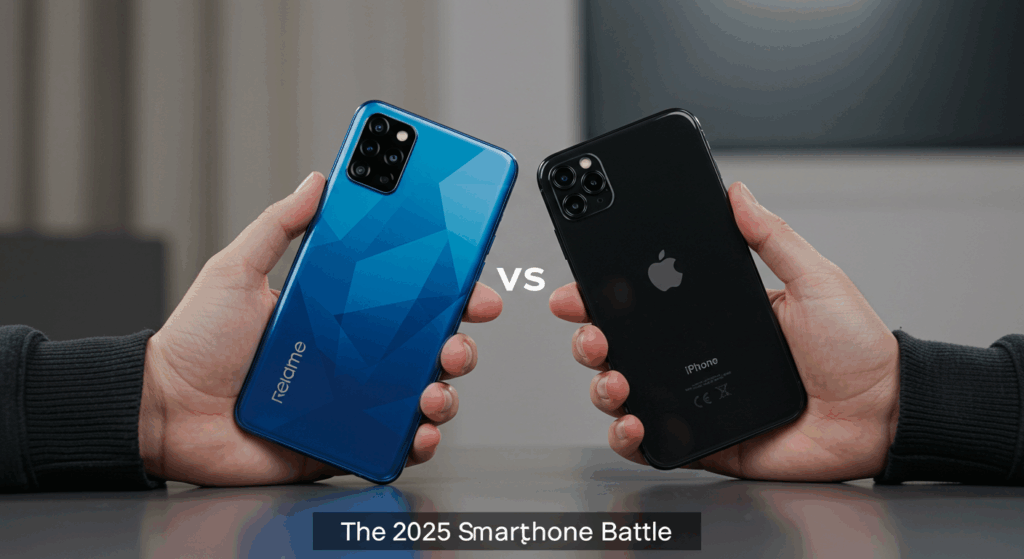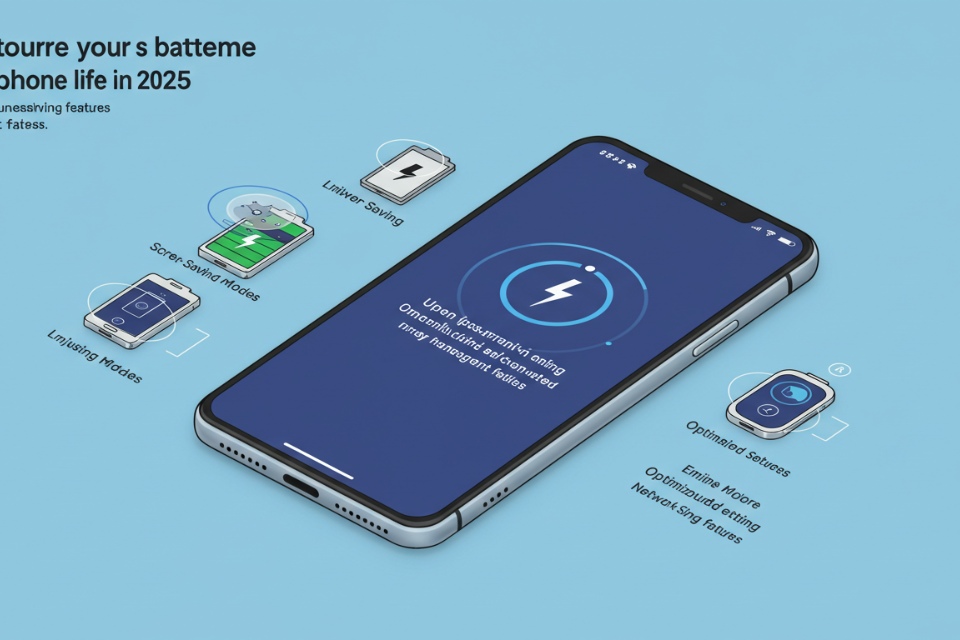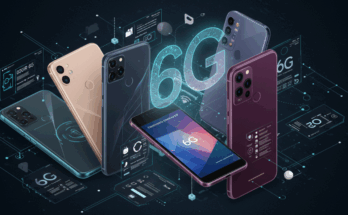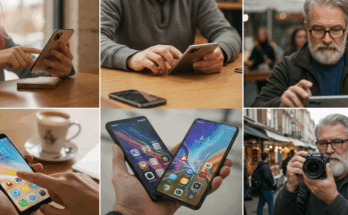In the ever-evolving world of smartphones, 2025 has brought another exciting showdown between two powerhouse devices: the Realme 15 Pro and the Apple iPhone 16. These flagship contenders cater to different audiences, with Realme offering high-end specs at a competitive price and Apple delivering its signature ecosystem integration and premium polish. This blog post dives deep into a head-to-head comparison of these devices, exploring their design, performance, cameras, battery life, software, and overall value to help you decide which phone reigns supreme in 2025.
Design and Build Quality: Style Meets Substance
Realme 15 Pro
The Realme 15 Pro continues the brand’s tradition of delivering sleek, modern designs that appeal to trendsetters. Expected to feature a slim profile with a glass back and aluminum frame, the Realme 15 Pro is likely to weigh around 190g, making it lightweight and comfortable for daily use. Its design emphasizes bold aesthetics, with vibrant color options like Suede Grey and Razor Green, often paired with a textured finish for better grip. The device is expected to boast an IP68 rating for water and dust resistance, ensuring durability in challenging conditions.
The Realme 15 Pro is rumored to sport a 6.7-inch AMOLED display with a 120Hz refresh rate and HDR10+ support, offering a vibrant and smooth visual experience. With a peak brightness of around 2000 nits, the display should remain legible even in direct sunlight. The phone’s slim bezels and punch-hole camera design maximize screen real estate, making it ideal for media consumption and gaming.
iPhone 16
Apple’s iPhone 16 sticks to its iconic design language, featuring a 6.1-inch Super Retina XDR OLED display with a 60Hz refresh rate—still a point of contention for some users hoping for ProMotion on the base model. The iPhone 16 is crafted with an aluminum frame and a matte glass back, available in sophisticated colors like Black Titanium and Desert Titanium. At approximately 170g, it’s slightly lighter than the Realme 15 Pro, offering a compact and premium feel.
The iPhone 16 introduces thinner bezels compared to its predecessor, the iPhone 15, enhancing the immersive viewing experience. Its Ceramic Shield glass (2024 gen) provides robust protection against drops, and the IP68 rating ensures water and dust resistance. The addition of the Camera Control button, a new feature for quick access to camera functions, adds a practical touch to the design, though its trackpad-like functionality has received mixed feedback for being gimmicky.
Verdict: The Realme 15 Pro edges out slightly in display fluidity with its 120Hz refresh rate, while the iPhone 16 offers a more compact form factor and premium materials. Design preference will depend on whether you prioritize a larger, vibrant display (Realme) or a sleek, ecosystem-driven aesthetic (Apple).
Performance: Power Under the Hood
Realme 15 Pro
Realme has consistently pushed the envelope with performance, and the Realme 15 Pro is expected to be powered by the Qualcomm Snapdragon 8 Gen 4 (or a similar high-end chipset), built on a 3nm process for superior efficiency and speed. Paired with up to 16GB of RAM and storage options ranging from 256GB to 1TB, the Realme 15 Pro is designed to handle demanding tasks like gaming, video editing, and multitasking with ease. Its thermal management system, a hallmark of Realme’s GT series, ensures sustained performance during intensive workloads.
Benchmarks like 3DMark Wild Life are likely to show the Realme 15 Pro competing closely with top-tier flagships, offering excellent graphical performance for gaming enthusiasts. The device’s compatibility with Wi-Fi 7 and 5G ensures blazing-fast connectivity, making it future-proof for next-gen networks.
iPhone 16
The iPhone 16 is powered by the Apple A18 chip, also built on a 3nm process (N3E), delivering a significant performance leap over the iPhone 15’s A16 Bionic. With 8GB of RAM (up from 6GB in the iPhone 15), the iPhone 16 is optimized for Apple Intelligence, Apple’s suite of AI-driven features. The A18 chip offers improved CPU and GPU performance, making it ideal for gaming, AR applications, and AI tasks like real-time photo processing.
While the iPhone 16’s performance is stellar, its 60Hz refresh rate can feel less responsive in fast-paced games compared to the Realme 15 Pro’s 120Hz display. However, Apple’s optimization ensures smooth operation across apps, and the Snapdragon X71 modem provides reliable 5G connectivity, though it’s slightly less advanced than the Pro model’s X75 modem.
Verdict: The Realme 15 Pro likely offers a slight edge in raw power and display fluidity, making it a better choice for gamers and heavy multitaskers. The iPhone 16, however, excels in optimized performance and AI integration, particularly for users invested in Apple’s ecosystem.
Camera Systems: Capturing the Moment
Realme 15 Pro
Realme has made significant strides in camera performance, and the Realme 15 Pro is expected to feature a triple-camera setup, likely including a 50MP main sensor, a 48MP ultrawide, and a 32MP telephoto lens with 3x optical zoom. The main sensor is rumored to use advanced computational photography, delivering sharp, vibrant images with excellent low-light performance. The ultrawide lens should offer improved detail compared to previous models, while the telephoto lens caters to portrait and zoom enthusiasts.
Video recording on the Realme 15 Pro is expected to support 8K at 30fps and 4K at 60fps, with enhanced stabilization for smooth footage. The front-facing camera, likely a 32MP sensor, should excel in selfies and video calls, with AI-driven enhancements for skin tones and background blur.
iPhone 16
The iPhone 16 features a dual-camera system with a 48MP main sensor and a 12MP ultrawide lens, arranged in a new vertical pill-shaped design. The main camera delivers exceptional detail and dynamic range, with Apple’s AI-driven processing (part of Apple Intelligence) enhancing color accuracy and low-light performance. The ultrawide lens supports macro photography, though it lags slightly behind competitors like the Huawei Pura 70 Ultra in background blur quality.
The iPhone 16’s video capabilities remain industry-leading, with 4K HDR recording at 60fps and cinematic modes for professional-grade footage. The new Camera Control button simplifies capturing photos and videos, though its advanced features may feel underutilized for casual users. The 12MP front camera delivers reliable selfies with accurate skin tones, though it’s less resolution-heavy than the Realme 15 Pro’s offering.
Verdict: The Realme 15 Pro’s versatile triple-camera setup and higher-resolution selfie camera make it a strong contender for photography enthusiasts. The iPhone 16, however, excels in video quality and AI-driven image processing, appealing to users who prioritize cinematic output.

Battery Life and Charging: Staying Powered Up
Realme 15 Pro
The Realme 15 Pro is expected to house a 5000mAh battery, a significant advantage over the iPhone 16. Coupled with Realme’s fast-charging technology, likely supporting 100W wired charging, the device can reach full charge in under 30 minutes. Wireless charging is also expected, potentially at 15W, aligning with industry standards for Android flagships.
Realme’s battery optimization, combined with the efficient Snapdragon 8 Gen 4, should deliver all-day battery life, even for heavy users. The device’s larger battery capacity makes it ideal for gaming, streaming, and multitasking without frequent recharges.
iPhone 16
The iPhone 16 features a 3561mAh battery, a 6% increase over the iPhone 15, offering solid endurance for daily use. However, its battery life is outclassed by the Realme 15 Pro’s larger capacity. Charging speeds remain a weak point, with wired charging capped at 20W and MagSafe wireless charging at 25W—faster than wired in some cases but still lagging behind Android competitors.
Apple’s optimization ensures efficient power management, but heavy users may need to recharge mid-day. The iPhone 16’s battery performance is better suited for casual users or those who rely on Apple’s ecosystem for seamless power-saving features.
Verdict: The Realme 15 Pro dominates in battery capacity and charging speed, making it the better choice for power-hungry users. The iPhone 16 offers reliable battery life but falls short in charging convenience.
Software: Ecosystems and Features
Realme 15 Pro
Running Realme UI 6.0 based on Android 15, the Realme 15 Pro offers a customizable and feature-rich experience. Realme UI is known for its vibrant animations, theme customization, and privacy features like app tracking controls. The device is expected to receive at least three years of OS updates and four years of security patches, ensuring longevity.
Realme’s software includes gaming optimizations, split-screen multitasking, and AI-driven features like voice assistants and photo editing tools. While not as polished as Apple’s iOS, Realme UI offers flexibility for users who enjoy tailoring their experience.
iPhone 16
The iPhone 16 ships with iOS 18.2, with updates to iOS 18.4 expected in early 2025, bringing a revamped Siri and deeper Apple Intelligence integration. iOS 26, slated for fall 2025, introduces a “Liquid Glass” visual style and dynamic wallpapers, enhancing the user interface. Apple’s ecosystem integration—spanning iCloud, AirDrop, and Apple Watch compatibility—remains unmatched, offering a seamless experience for users invested in Apple products.
However, the iPhone 16’s 60Hz display and delayed Apple Intelligence features (like the smarter Siri) have drawn criticism, especially at its $799 price point. Apple’s privacy features, like Mail Privacy Protection, continue to set the standard for data security.
Verdict: The iPhone 16’s polished ecosystem and long-term software support make it ideal for Apple loyalists. The Realme 15 Pro offers greater customization and faster software updates, appealing to Android enthusiasts.
Pricing and Value
Realme 15 Pro
Expected to start at around $600-$700, the Realme 15 Pro offers flagship-level specs at a mid-range price. Its combination of a high-refresh-rate display, powerful chipset, versatile cameras, and fast charging makes it a compelling value proposition for budget-conscious buyers seeking premium performance.
iPhone 16
Priced at $799, the iPhone 16 is significantly more expensive, with storage options starting at 128GB. While Apple’s brand value and ecosystem justify the cost for some, the lack of a 120Hz display and slower charging speeds make it less competitive against Android flagships like the Realme 15 Pro.
Verdict: The Realme 15 Pro offers better value for money, delivering high-end features at a lower price. The iPhone 16’s premium pricing is best suited for users prioritizing Apple’s ecosystem and long-term reliability.
Conclusion: Which Phone Wins in 2025?
The Realme 15 Pro is a powerhouse that excels in performance, battery life, and value, making it the go-to choice for gamers, power users, and budget-conscious buyers. Its 120Hz display, fast charging, and versatile camera system give it an edge in raw specs and affordability.
The iPhone 16, while not revolutionary, delivers a polished experience with unmatched ecosystem integration, superior video quality, and long-term software support. It’s the better pick for Apple enthusiasts and those who value a seamless, secure user experience.
Ultimately, the choice depends on your priorities: raw power and value (Realme 15 Pro) or ecosystem synergy and polish (iPhone 16). In the 2025 smartphone battle, both devices shine, but the Realme 15 Pro takes the crown for offering flagship features at a fraction of the cost.



